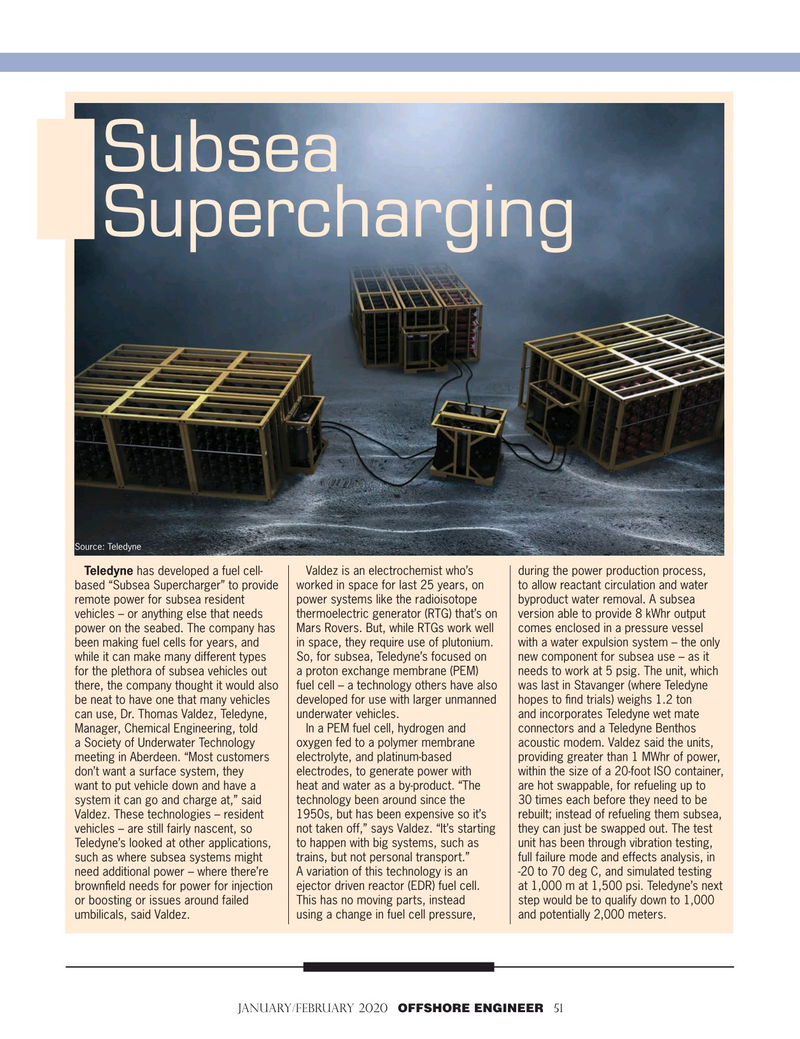
Page 51: of Offshore Engineer Magazine (Jan/Feb 2020)
Read this page in Pdf, Flash or Html5 edition of Jan/Feb 2020 Offshore Engineer Magazine
Subsea
Supercharging
Source: Teledyne
Teledyne has developed a fuel cell- Valdez is an electrochemist who’s during the power production process, based “Subsea Supercharger” to provide worked in space for last 25 years, on to allow reactant circulation and water remote power for subsea resident power systems like the radioisotope byproduct water removal. A subsea vehicles – or anything else that needs thermoelectric generator (RTG) that’s on version able to provide 8 kWhr output power on the seabed. The company has Mars Rovers. But, while RTGs work well comes enclosed in a pressure vessel been making fuel cells for years, and in space, they require use of plutonium. with a water expulsion system – the only while it can make many different types So, for subsea, Teledyne’s focused on new component for subsea use – as it for the plethora of subsea vehicles out a proton exchange membrane (PEM) needs to work at 5 psig. The unit, which there, the company thought it would also fuel cell – a technology others have also was last in Stavanger (where Teledyne be neat to have one that many vehicles developed for use with larger unmanned hopes to ? nd trials) weighs 1.2 ton can use, Dr. Thomas Valdez, Teledyne, underwater vehicles. and incorporates Teledyne wet mate
Manager, Chemical Engineering, told In a PEM fuel cell, hydrogen and connectors and a Teledyne Benthos a Society of Underwater Technology oxygen fed to a polymer membrane acoustic modem. Valdez said the units, meeting in Aberdeen. “Most customers electrolyte, and platinum-based providing greater than 1 MWhr of power, don’t want a surface system, they electrodes, to generate power with within the size of a 20-foot ISO container, want to put vehicle down and have a heat and water as a by-product. “The are hot swappable, for refueling up to system it can go and charge at,” said technology been around since the 30 times each before they need to be
Valdez. These technologies – resident 1950s, but has been expensive so it’s rebuilt; instead of refueling them subsea, vehicles – are still fairly nascent, so not taken off,” says Valdez. “It’s starting they can just be swapped out. The test
Teledyne’s looked at other applications, to happen with big systems, such as unit has been through vibration testing, such as where subsea systems might trains, but not personal transport.” full failure mode and effects analysis, in need additional power – where there’re A variation of this technology is an -20 to 70 deg C, and simulated testing brown? eld needs for power for injection ejector driven reactor (EDR) fuel cell. at 1,000 m at 1,500 psi. Teledyne’s next or boosting or issues around failed This has no moving parts, instead step would be to qualify down to 1,000 umbilicals, said Valdez. using a change in fuel cell pressure, and potentially 2,000 meters.
JANUARY/FEBRUARY 2020 OFFSHORE ENGINEER 51

 50
50

 52
52